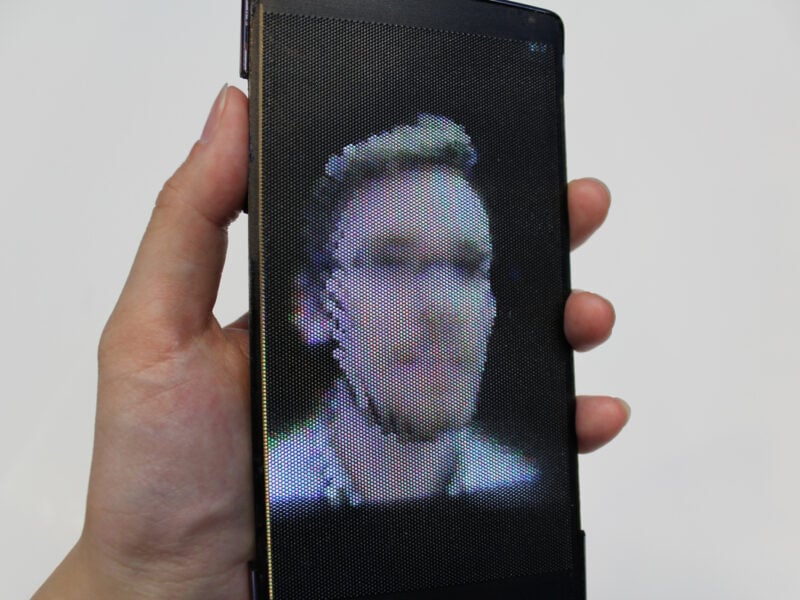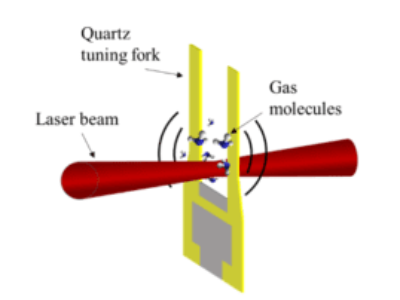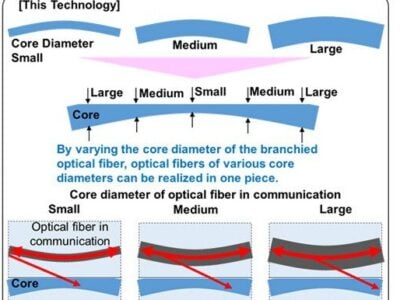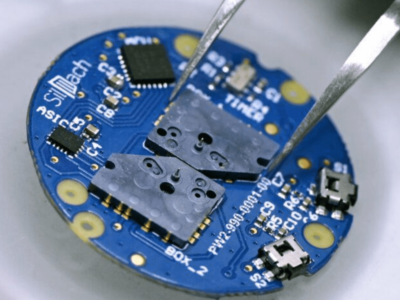
32K OLED resolution in demand for holographic smartphones
The researchers laminated a flexible micro-lens array on top of the OLED-based ReFlex flexible smartphone they had demonstrated back in February to turn its bendable touch-display into a light-field capable interface. Combined with custom ray-tracing algorithms running on the phone’s GPU, the flexible display renders holographic-like 3D images with motion parallax and stereoscopy to multiple simultaneous users without head tracking or glasses.
For this prototype, the researchers used 3D-printing to fabricate a matrix of 16,000 fish-eye lenses (only 0.75mm wide each) and cover a 1920×1080 full high-definition OLED display with it (403dpi with about a 0.063mm pixel pitch). Since each micro-lens dome covers 12-pixel wide sub-images (in fact a circular image made of approximately 80 pixels), they each contribute a pixel block of the entire scene from a particular virtual camera position with a 35º field of view (determined by the optical properties of the micro-lenses). Altogether, this yields a 160×104 resolution image floating in 3D a few centimetres off the actual screen, to be viewed from any angle.

and half-dome microlens array dispersing light rays.
As for the ReFlex smartphone, touch input allows for x,y input, while bend sensors allow users to control the z dimension, by squeezing the display.
Since the final image is accumulative of the many rays from the light-field display (and the sub-image resolution under each micro-lens), at what sort of OLED screen resolutions would the image quality become visually acceptable for OEMs and consumers to adopt such holographic displays? We asked Dr. Roel Vertegaal, Professor of Human-Computer Interaction at Queen’s University’s School of Computing in Kingston, Ontario, and director of the Human Media Laboratory.
“I think when mobile displays reach 16K or 32K and pixel pitch 4 micron to 2 microns the quality would be similar to what we are used to today in 2D screens”, Vertegaal wrote eeNews Europe.
That’s orders of magnitude the resolution of today’s top of the range Ultra HD 4K smartphones (3840×2160 pixels), not even a mainstream feature, but some micro-OLED manufacturers are nearing such pixel pitches (at undisclosed yields).
With higher native screen resolutions, the micro-lens could not only be shrunk, but each dome may also pack more pixel information (finer sub-images) for a better rendering. The micro-lens array has still plenty of scope to be shrunk, using nano-imprint technologies for example.
“The current size of the micro-lenses is about 12 pixels across which is acceptable for 3D content that is within 1-2 cm depth-wise of the display. I think a commercial product might double that (which would conversely double the required resolution I mentioned earlier”, Vertegaal clarified.
“I think the two main limiting factors today (provided we can make the micro-lens array as small as needed) are screen resolution and GPU architecture and power. As mentioned in our paper the 3D content is rendered using a ray tracing algorithm which is computationally expensive and hardware support for ray tracing in mobile GPUs would be nice”, he continued.
When asked if the technology would become licensable IP through Immersion Inc., a backer of this research, or if the professor would conceive establishing a startup to commercialize the solution together with display OEMs, Vertegaal eluded the question.
“We did patent the device but cannot comment on further commercialisations activity”, he answered.
Providing OLEDs reach the required pixel pitch, example applications could be to use the bend gestures of the HoloFlex for Z-Input to facilitate the editing of 3D models, swiping the screen to manipulate objects in the x and y axes while squeezing the display to move objects along the z-axis.
Combined with a depth camera, users could also indulge in holographic video conferences with one another, envisions Dr. Vertegaal. Holographic gaming is another promising application, in fact, the researchers rendered a 3D version of Angry Birds, where bending the side of the display would pull the elastic rubber band that propels the bird. Sending the bird to fly over the screen, in the third dimension.
Visit Queen’s University Human Media Lab at www.hml.queensu.ca
Related articles:
Flexible OLED-based smartphone combines multitouch with bend input
Holographic smartphone created in China wins 2015 CES Innovations Award
 If you enjoyed this article, you will like the following ones: don't miss them by subscribing to :
eeNews on Google News
If you enjoyed this article, you will like the following ones: don't miss them by subscribing to :
eeNews on Google News



